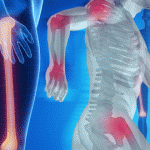In 59,970 twins aged 35 years or older, Magnusson et al. compared how much genetics contributes to osteoarthritis (OA) with the genetic contribution to other rheumatic/musculoskeletal diseases (RMDs) in the same population, while exploring the role of shared genetics in OA and other RMDs. The researchers used data from the Swedish Twin Registry, in addition to the Swedish National Patient Register. They concluded that the heritability (i.e., the total genetic contribution to a trait) of OA is relatively large compared with other rheumatic musculoskeletal diseases.

Muscle Pathology for the Rheumatologist
Understanding muscle pathology reports is important to best treat rheumatology patients. Peter Pytel, MD, shared pearls of wisdom specific to the autoimmune inflammatory myopathies and gave a detailed review of what rheumatologists need to know, during the 2022 ACR Education Exchange.
Global Prevalence & Burden of Musculoskeletal Disorders
Musculoskeletal disorders pose a large burden globally, but that burden is often underappreciated. Safiri et al. set out to provide a global overview of this burden, reporting the levels and trends of prevalence, deaths and disability-adjusted life years due to musculoskeletal disorders according to age, sex and sociodemographic factors.

The Case for Integrated Musculoskeletal Care Teams
Through the development of a multidisciplinary musculoskeletal institute, we have created a model that facilitates coordination of care of complex patients between medical and surgical subspecialists, physical therapists, dieticians and social workers. A case is presented to demonstrate the improved care experience for both patients and providers and to share our learnings more broadly. The…
Coding Corner Answer: Coding Scenario for 1997 Musculoskeletal Exam
Take the challenge. CPT codes: 99203/99243 ICD-10: M25.521, M25.522, M25.561, M25.562 History—Comprehensive: The history of present illness is extended, the review of systems is complete, and the past medical, family and social history are documented. All three of the HPI, ROS and PFSH are needed to achieve the history level as comprehensive. Examination—Detailed: This level…
Coding Corner Question: Coding Scenario for 1997 Musculoskeletal Exam
A 55-year-old female patient with pain in multiple joints is referred to the office by her primary care physician. She complains of pain in both knees and both shoulders. She rates the pain at 7 on the pain scale. Her pain is worse at night after she gets off work. Soaking in her hot tub…

The Right Load: Insights into Age-Impaired Mechanoadaptive Cortical Bone Response
Aging bones lose their ability to mechanoadapt, but new research suggests age-related adaptation failure may result from insufficient mechanical stimulus…
Recommendations for Sjögren’s Syndrome: How to Address Biologics & Musculoskeletal Pain
The clinical practice guidelines for managing Sjögren’s syndrome, developed by the Sjögren’s Syndrome Foundation with the ACR, were designed to improve quality and consistency of care. In total, 19 recommendations were agreed on, which include managing the rheumatic and systemic aspects of the disease. Recommendations include a decision tree for the use of DMARDs for inflammatory musculoskeletal pain, use of self-care measures and exercise to reduce fatigue, and the use of rituximab in selected clinical settings for oral and ocular dryness…

Spinal Underwear May Relieve Lower Back Pain
A recent study in nurses and healthcare professionals examined the efficacy of a novel ergonomic aid for managing low back pain. After a three-month trial, researchers found that the aid, Spinal Underwear, reduced low back pain, suggesting that musculoskeletal symptoms may be influenced by posture and somatization…

Mesenchymal Stem Cell Therapy May Help Slow, Repair Degenerative Signs of Osteoarthritis, Musculoskeletal Disease
WASHINGTON, D.C.—For patients with osteoarthritis and other age-related musculoskeletal diseases, treatment with mesenchymal stem cells may soon offer a potent way to slow and repair degenerative signs of disease. This is the goal, a goal that is moving from the laboratory to the clinic as results from ongoing randomized clinical trials show the safety and…